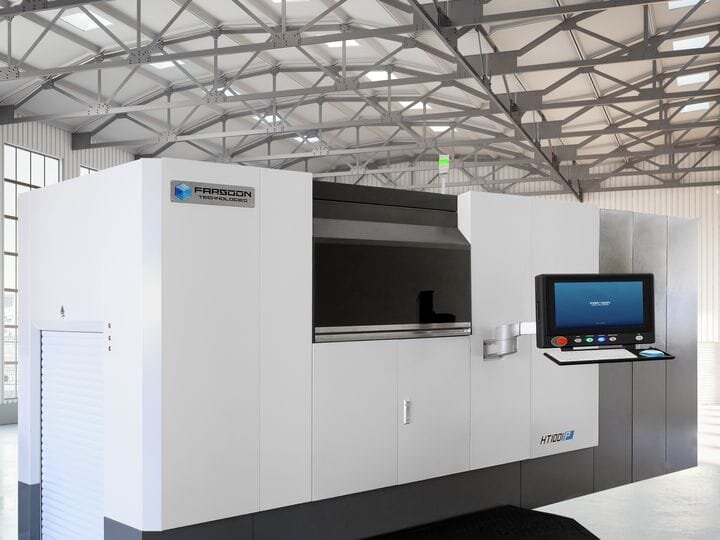![The HT1001P CAMS continuous 3D printing system [Source: Farsoon]](https://fabbaloo.com/wp-content/uploads/2020/05/image-asset_img_5eb08d3b6d240.jpg)
Farsoon has completed testing of their HT1001P CAMS 3D printer.
The China-based company announced their “CAMS”, or “Continuous Additive Manufacturing System” a while ago, but have now completed extensive beta testing on the system with two companies in Europe: Modellbau Kurz GmbH in Gerlingen near Stuttgart and FKM Sintertechnik GmbH. Both companies were very satisfied with the results of their test.
Farsoon SLS Systems
![Nylon automotive grill produced on a HT1001P CAMS system [Source: Farsoon]](https://fabbaloo.com/wp-content/uploads/2020/05/image-asset_img_5eb08d3badb2c.jpg)
The HT1001P CAMS system is an additive manufacturing device that uses the SLS 3D printing process, with powerful lasers sweeping across a flat bed of powder. It is used to produce strong, high-detail thermoplastic objects, typically in nylon materials.
Continuous Additive Manufacturing
The word “Continuous” means different things in the 3D printing space depending on who you’re asking. One concept is that objects of infinite dimensions can be printed. Another is that objects can be repeatedly produced continuously without the need for operator intervention as the device “clears” itself in some manner after each print completes.
But when considering a powder bed / laser SLS process, it’s a bit hard to imagine how “infinite” dimensions could be attempted. Fortunately, that’s not what Farsoon is doing with their HT1001P CAMS system. Instead it is a means of automating the post-print clearing process.
![Simon Dirk [Source: Farsoon]](https://fabbaloo.com/wp-content/uploads/2020/05/image-asset_img_5eb08d3bedaf8.jpg)
Dr. Dirk Simon, Managing Director of Farsoon Europe, explains how CAMS works:
“The HT1001P is the first of Farsoon’s systems to be developed according to the CAMS concept, which means that the HT1001P is designed for continuous series production and possesses a modular conveying system. The build cylinder is automatically brought by the loading station into the build zone and then into the cooling station.
Together with the automatic powder feed from above, this allows intensive production cycles, while the build cylinders can be changed overnight or at the weekend.
With such a large build volume, one meter wide, 50 cm deep and 45 cm high, I consider heat management is a big challenge. The larger the build volume, the longer the powder cake remains at a high temperature. The cooling time increases disproportionately as a result. Therefore, two lasers are used to scan very rapidly, and then cooling is carried out actively in the cooling station.”
SLS Cooling Challenges
This is the challenge of large-volume powder systems: heat management. HP has a similar challenge with their MJF process, and indeed offers a similar solution to Farsoon: separate the building and cooling processes to create a kind of overlapping pipeline of activities.
Even if the cooling time for a chamber takes longer than the build time of the next print, this approach still works because you can simply add another build chamber to the process. You can have multiple cooling chambers while another is being built in the 3D printer.
The result is a high throughput of objects produced, which is simply the total elapsed time for the process divided by the number of units produced. This process is not one for those requiring quick individual 3D prints; it is for those requiring production volumes.
Production SLS Additive Manufacturing
![Niko Kurz operating a HT1001P CAMS 3D printing system [Source: Farsoon]](https://fabbaloo.com/wp-content/uploads/2020/05/image-asset_img_5eb08d3c298ca.jpg)
That means the HT1001P CAMS system is designed to be running flat out, as close to 24/7 as possible. This is good news for the CFO’s of purchasing organizations, as the device would be in theory able to generate revenue all the time.
It also means the HT1001P CAMS is truly a production system as per our definition of a “Production 3D Printer”.
As an automated production machine, the most visible activity aside from collecting completed prints will continually reloading the machine with input thermoplastic powder. In fact, both of the beta testers independently called the HT1001P CAMS a “Powder Eater”.
With the end of the beta testing, it is likely that Farsoon will begin marketing the HT1001P CAMS system to the public in short order.
Via Farsoon

